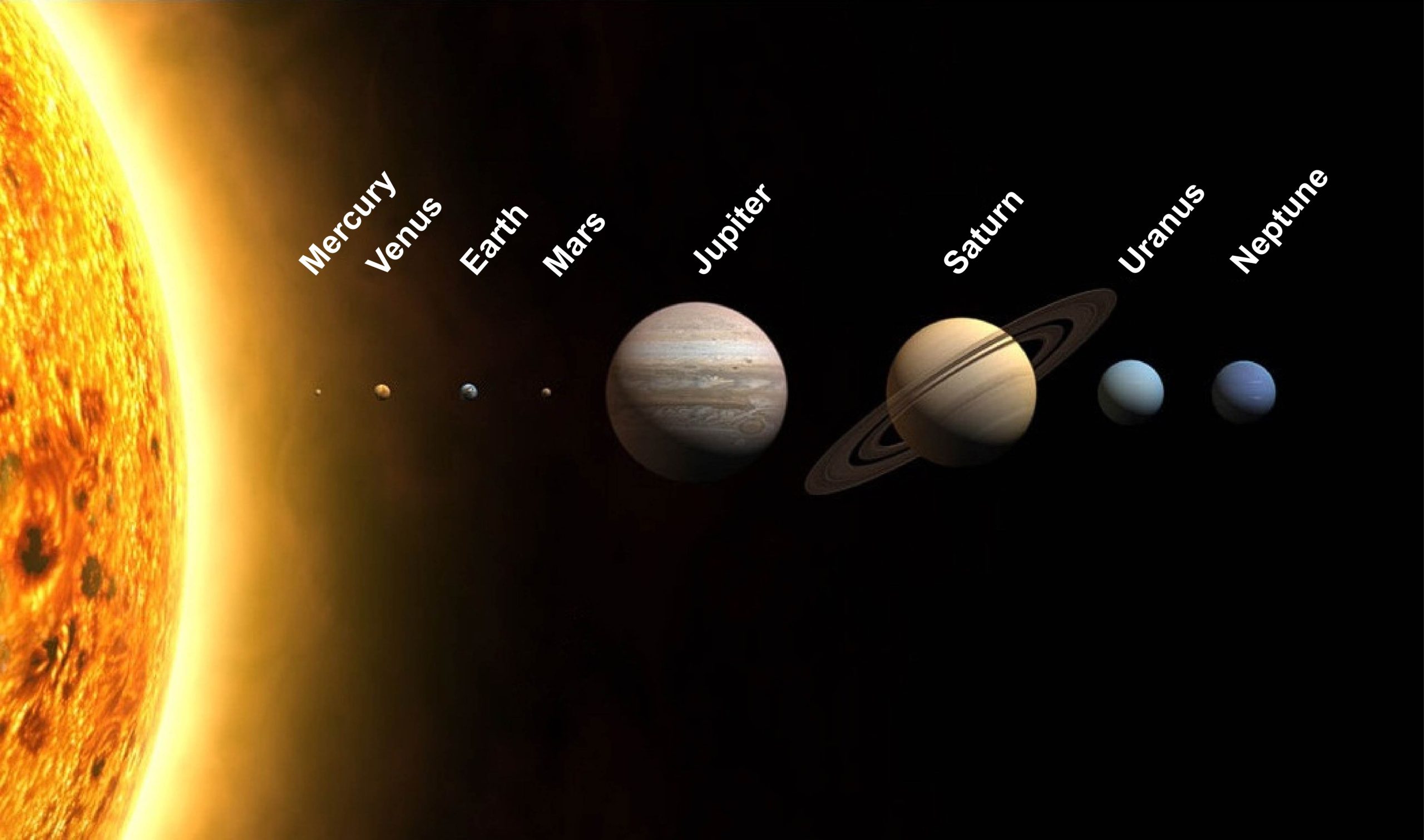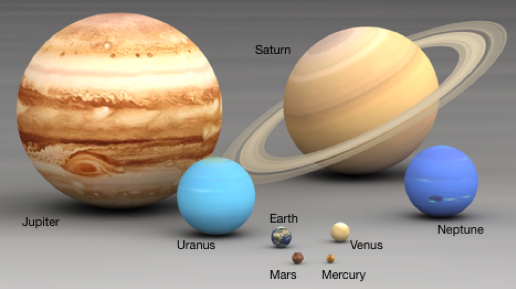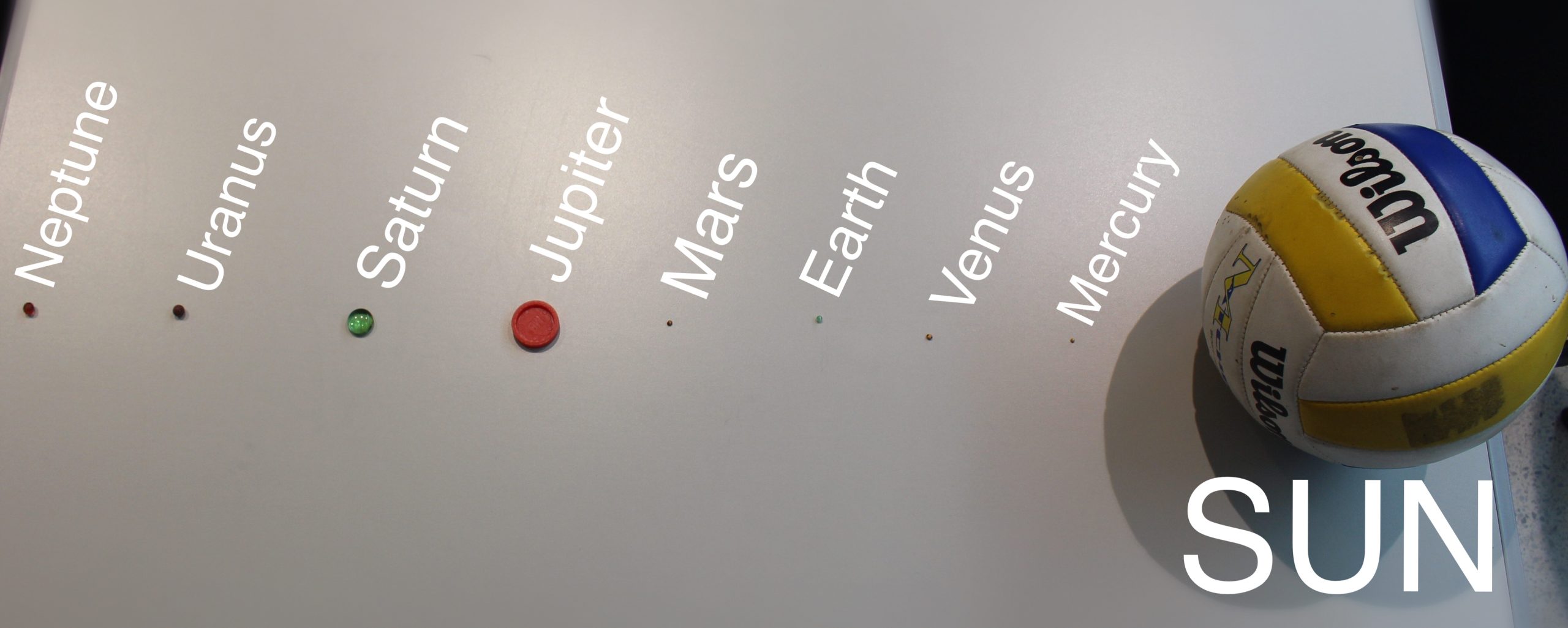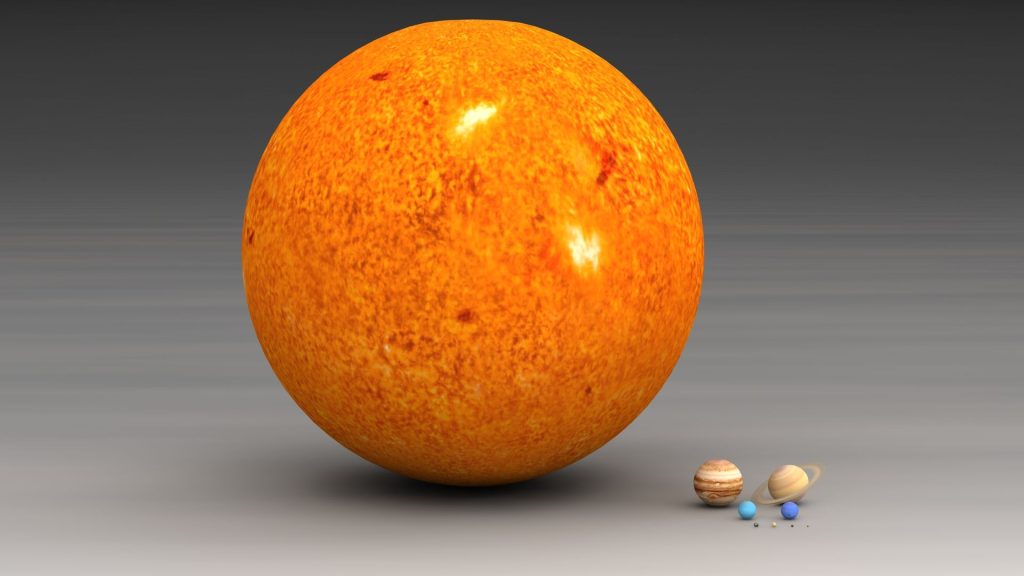Week 4: Our Solar System
Dr. Ted Neal and Alexis Hatvick
Formative Assessment: Stars
Planets

There are 8 planets in our solar system: Mercury, Venus, Earth, Mars, Jupiter, Saturn, Uranus, and Neptune. To remember the order of the planets (closest to farthest from the sun), use the acronym “My Very Educated Mother Just Served Us Nutella.”
The four inner planets–Mercury, Venus, Earth, and Mars–are rocky planets because they have a solid surface. The four outer planets–Jupiter, Saturn, Uranus, and Neptune–are gaseous planets because they are composed of gases, mainly hydrogen and helium. Notice that the rocky planets are much smaller in size and the gaseous planets are larger. One theory for this is that when the Sun turned on and became a star, it caused the gas clouds of the four inner planets to blow away. The rocky planets were left with a smaller, solid planet. The gaseous planets are farther from the sun, so they retained their composition. As they increased in mass, their gravity increased which allowed them to attract more and more material from space and grow larger in size.
Sizes and Distances of Planets
The image below shows the huge variance in size between planets in our solar system. Notice the differences in size between the inner, rocky planets and the outer, gaseous planets.

Measurements of Our Solar System
| Element | Diameter (km) | Distance from the Sun (x106) (km) |
| Sun | 1,392,000 | ————————– |
| Mercury | 4,897 | 57.9 |
| Venus | 12,104 | 108.2 |
| Earth | 12,756 | 149.6 |
| Mars | 6,794 | 227.9 |
| Jupiter | 142,980 | 778.6 |
| Saturn | 120,540 | 1433.5 |
| Uranus | 51,120 | 2872.5 |
| Neptune | 49,530 | 4495.1 |
Watch the following video to see a size comparison of the planets across Iowa’s campus.

To understand the scale of the Hubble eXtreme Deep Field, watch the video below:
Video credit: “How Small are We in the Scale of the Universe?” by Alex Hofeldt/TED-Ed is licensed under CC BY-NC-ND 4.0
Why is Pluto Not a Planet?
Pluto was the ninth planet in our solar system until a controversial 2006 decision when it was reclassified as a dwarf planet. Pluto meets two requirements to be a planet: it orbits around the sun and its gravity formed the planet into a round shape. However, it does not meet the third requirement of “clearing the neighborhood.” Planets must have gravitational dominance and clear the neighborhood around their orbit; this means that large planets (more mass=more gravity) either attract or eject other, smaller bodies from that region of space. Several other dwarf planets and similarly-sized space objects were discovered in the solar system near Pluto’s orbit in the Kuiper Belt. Therefore, Pluto has not cleared the neighborhood and so it cannot be considered a planet.

The Big Bang: Origins of our Universe
The Big Bang is the best-supported scientific theory for how the universe was created. 13.7 billion years ago there was nothing and nowhere. Everything that ever existed was contained in a subatomic particle that was billions of times smaller than an atom. Within a fraction of a second, this amazingly tiny particle stretched and inflated to an unimaginably huge size. Space, time, and the fundamental particles of the universe were created in this instant.
Key Takeaway
Although the word “bang” is part of the name, the Big Bang was an expansion or an inflation rather than an explosion.
Although there are alternate theories, the Big Bang theory is supported by multiple sources of scientific evidence.
- Edwin Hubble discovered that the universe is still expanding today. If it is constantly expanding and growing now, that means it was smaller before–and likely the size of an unimaginably small particle at the beginning.
- Scientists detected Cosmic Microwave Background, a type of radiation that is present everywhere in the universe. Evidence suggests that this is leftover radiation from the energy of the Big Bang.
For more explanation of the Big Bang theory, watch the following video.
Video credit: “Big Bang Introduction” by Khan Academy is licensed under CC BY-NC-SA 3.0. Note: All Khan Academy content is available for free at khanacademy.org.
Origins of the Sun, Earth, and Moon
Our solar system was most likely formed from a giant rotating nebula after a former star underwent a supernova. 4.65 billion years ago, this rotation and intense gravity caused the nebula to collapse on itself. This caused it to spin faster and flatten into a disk shape, the Plane of the Ecliptic. Much of this material was pulled toward the center of the disk and a star was formed: the Sun. The Sun contains 99.8% of the mass in our solar system.

Although it is enormous compared to the size of Earth, the Sun is an average-sized star. It is mostly made of hydrogen and helium. Currently, it is halfway through its fuel supply. In around 5-6 billion years, the Sun will burn all of its fuel and become a white dwarf star.
After the Plane of the Ecliptic was formed, the planets formed from the leftover gas and dust orbiting around the Sun. One theory says that when the Sun turned on and became a star, the force of its energy blew off the gas clouds around the four inner planets which is why they are rocky and the outer planets are gaseous. Earth, a rocky planet, is about 4.65 billion years old. Scientists believe that life on Earth appeared approximately 3.5 billion years ago, based on evidence found in fossils.
For more detail of how space dust turns into planets, watch the video below:
Video credit: “The Dust Bunnies That Build Our Planet” by Lorin Swint Matthews/TED-Ed is licensed under CC BY-NC-ND 4.0
Key Takeaway
Earth was NOT formed during the Big Bang.
- The Big Bang occurred 13.7 billion years ago.
- Earth was formed 4.65 billion years ago.
- This means there is a lapse of 9 billion years between the Big Bang and the formation of Earth.
NGSS:
K-6 Standards
5-ESS1-1. Support an argument that differences in the apparent brightness of the sun
compared to other stars is due to their relative distances from Earth.
| 1-ESS1-1. | Use observations of the sun, moon, and stars to describe patterns that can be predicted. [Clarification Statement: Examples of patterns could include that the sun and moon appear to rise in one part of the sky, move across the sky, and set; and stars other than our sun are visible at night but not during the day.] [Assessment Boundary: Assessment of star patterns is limited to stars being seen at night and not during the day.] |
|---|
| MS-ESS1-1. | Develop and use a model of the Earth-sun-moon system to describe the cyclic patterns of lunar phases, eclipses of the sun and moon, and seasons. [Clarification Statement: Examples of models can be physical, graphical, or conceptual.] |
|---|
ESS1.A: The Universe and its Stars
Fifth Grade
ESS1.B: Earth and the Solar System
Middle School
ESS1.A: The Universe and Its Stars
ESS1.B: Earth and the Solar System
- The solar system consists of the sun and a collection of objects, including planets, their moons, and asteroids that are held in orbit around the sun by its gravitational pull on them. (MS-ESS1-2),(MS-ESS1-3)
- This model of the solar system can explain eclipses of the sun and the moon. Earth’s spin axis is fixed in direction over the short-term but tilted relative to its orbit around the sun. The seasons are a result of that tilt and are caused by the differential intensity of sunlight on different areas of Earth across the year. (MS-ESS1-1)
Crosscutting Concepts
Patterns
– – – – – – – – – – – – – – – – – – – – – – – – – – – – – – – – – – – –
Connections to Nature of Science
Scientific Knowledge Assumes an Order and Consistency in Natural Systems
- Science assumes natural events happen today as they happened in the past. (1-ESS1-1)
- Many events are repeated. (1-ESS1-1)
Lesson ideas:
Take children outside to see the Moon in the daytime. Show them how to observe the Moon, and keep a Moon journal, and encoruage them to look for the Moon day and night. Look at your Moon journal to see what the patterns are.
Try to recreate what they see outside with the Earth Sun Moon system.
Performance Expectations
| 5-ESS1-1. | Support an argument that differences in the apparent brightness of the sun compared to other stars is due to their relative distances from the Earth. [Assessment Boundary: Assessment is limited to relative distances, not sizes, of stars. Assessment does not include other factors that affect apparent brightness (such as stellar masses, age, stage).] |
|---|
| 5-PS2-1. | Support an argument that the gravitational force exerted by Earth on objects is directed down. [Clarification Statement: “Down” is a local description of the direction that points toward the center of the spherical Earth.] [Assessment Boundary: Assessment does not include mathematical representation of gravitational force.] |
|---|
| MS-ESS1-2. | Develop and use a model to describe the role of gravity in the motions within galaxies and the solar system. [Clarification Statement: Emphasis for the model is on gravity as the force that holds together the solar system and Milky Way galaxy and controls orbital motions within them. Examples of models can be physical (such as the analogy of distance along a football field or computer visualizations of elliptical orbits) or conceptual (such as mathematical proportions relative to the size of familiar objects such as students’ school or state).] [Assessment Boundary: Assessment does not include Kepler’s Laws of orbital motion or the apparent retrograde motion of the planets as viewed from Earth.] |
|---|
| MS-ESS1-3. | Analyze and interpret data to determine scale properties of objects in the solar system. [Clarification Statement: Emphasis is on the analysis of data from Earth-based instruments, space-based telescopes, and spacecraft to determine similarities and differences among solar system objects. Examples of scale properties include the sizes of an object’s layers (such as crust and atmosphere), surface features (such as volcanoes), and orbital radius. Examples of data include statistical information, drawings and photographs, and models.] [Assessment Boundary: Assessment does not include recalling facts about properties of the planets and other solar system bodies.] |
|---|
DCI
5th Grade
PS2.B: Types of Interactions
ESS1.A: The Universe and its Stars
middle School
ESS1.B: Earth and the Solar System
Crosscutting Concepts
Patterns
Cause and Effect
Scale, Proportion, and Quantity
Patterns
Scale, Proportion, and Quantity
Systems and System Models
Scientific theory for how the universe was created.
A cloud of gas and dust in space.
The giant explosion of a supermassive star at the end of its life cycle.
The disk-shaped plane in which everything in our solar system orbits around the Sun.

